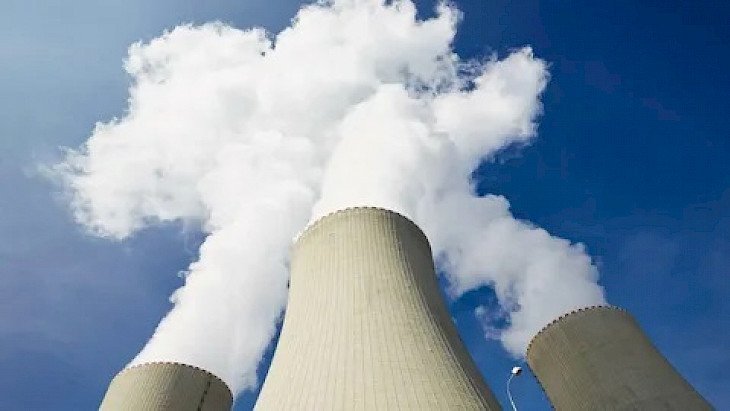BISHKEK – Central Asia is entering an era where the traditional reliance on hydropower no longer guarantees the future stability of its energy balance. At the roundtable discussion “Water or Peaceful Atom? Prospects for Solving Energy Problems in Central Asia Amid Water Scarcity,” organized by the Center for Strategic Initiatives “Oy Ordo” in Bishkek, representatives of government bodies, diplomats, and experts debated whether nuclear energy could become a solution in the face of melting glaciers and growing energy needs.
Dalbaev: Glaciers Are Retreating, Water Is Depleting – Hydropower Has Less Support
Taalaibek Dalbaev, Director of the Department of State Regulation in the Field of Environmental Protection and Ecological Safety at the Ministry of Natural Resources, Ecology and Technical Supervision of the Kyrgyz Republic, emphasized that energy shortages are already a reality not only for Kyrgyzstan but for the entire Central Asian region.
“Climate change is rapidly shrinking glaciers — they have decreased by 16% in recent years. The most intensive loss is happening at altitudes up to 4,000 meters. Less water means higher risks for hydropower,” he noted.
According to Dalbaev, renewable sources like solar and wind alone will not be enough to meet rising demand. Nuclear energy, he said, is capable of providing a stable base load, and interest in a small nuclear power plant (NPP) project in Kyrgyzstan is becoming tangible, with talks and agreements already underway.
However, Dalbaev stressed the importance of a careful, step-by-step approach: “We must not rush. Everything must be done strictly in line with international safety standards.” Kyrgyzstan is currently at the first stage of nuclear program preparation, which involves updating legislation. The Jogorku Kenesh (Parliament) has already passed the “Radiation Safety” law and ratified two key conventions — “Assistance in the Event of a Nuclear Accident” and “Notification in the Event of a Nuclear Accident.” The next challenge is to create a comprehensive legal framework to govern all stages of a nuclear plant’s lifecycle — from construction and operation to decommissioning.
He also highlighted the advantages of small modular reactors (SMRs): lower capital costs, smaller infrastructure requirements, higher seismic resistance, and adaptability for remote regions. However, Kyrgyzstan’s seismicity means that any NPP project must strictly follow IAEA standards and minimize ecological and technical risks. Dalbaev warned that the preparatory phase could last up to 10 years.
Dzhekshenkulov: Society Must Be Informed, Political Will Is Key
Alibek Dzhekshenkulov, Professor, Doctor of Political Science, and member of the Kyrgyz Presidential Council, approached the issue from a broader perspective:
“Either the government takes responsibility and decides to build a nuclear plant, or we hold a referendum,” he said. According to him, nuclear energy should be viewed through three interconnected lenses: geopolitics, economics, and ecology.
He stressed the troubling trend of a drying climate, citing international forecasts that predict droughts within the next decade. Kyrgyzstan and Tajikistan, being upstream countries, may feel the problem less for now, “but what happens when the glaciers are gone and river flows diminish?” Kazakhstan and Uzbekistan have already committed to nuclear power — a strategic move, Dzhekshenkulov believes.
Public perception is another challenge. “The word ‘nuclear’ still scares people — because of Chernobyl and Fukushima. We need extensive awareness campaigns,” he said. As a former Kyrgyz representative at the IAEA, he praised Russian nuclear technologies and expressed support for building an NPP in Kyrgyzstan, provided safety is guaranteed.
Dzhekshenkulov also called on Central Asian leaders to treat energy and water issues as an integrated package: nuclear + hydropower (including Kambar-Ata-1) + renewables + ecology + regional cooperation. He even reminded participants of the once-discussed Soviet project to redirect Siberian rivers to Central Asia, suggesting that water scarcity could become a defining factor for the future of the Eurasian Economic Union.
Niyazkhodjaev: Decide on the Economic Model First
Saidikram Niyazkhodjaev, Ambassador of Uzbekistan to Kyrgyzstan, brought a pragmatic perspective:
“First, we need to answer what kind of economy we want — agrarian, resource-based, or high-tech. If we want industries that produce goods with high added value, we need stable and abundant energy.”
The choice then becomes one of sources: green energy, thermal power plants, or nuclear energy. Every country, he emphasized, must align its potential with its development strategy. Uzbekistan has made significant progress — legal frameworks are in place, and specialist training is underway: a branch of the former Moscow Power Engineering Institute (MPEI) operates in Tashkent, and training is also conducted in Russia. “We are ready to share our expertise with our Kyrgyz partners,” he added.
When talking about green energy, the ambassador noted that hydropower is also part of the green spectrum, but large reservoirs bring ecological challenges. “The drying of the Aral Sea is often blamed on cotton, but we shouldn’t forget that water didn’t reach the Aral while new lands were developed and hydraulic structures were built.”
As for Kambar-Ata-1, environmental issues have been revisited, and preparation for implementation is ongoing. According to Niyazkhodjaev, financing is expected to be approved by the end of the year. This shows that major hydro projects and nuclear initiatives can advance in parallel, provided they are backed by proper engineering and environmental oversight.
Takeaway
The roundtable underscored that energy security in Central Asia is directly tied to climate, water resources, and regional cooperation. While hydropower remains vital for mountainous countries, melting glaciers and rising consumption make it essential to find new base-load solutions. Nuclear energy is increasingly in focus, but the path to it is long — requiring legal reforms, workforce training, environmental assessments, public dialogue, and regional coordination.
If Central Asian nations manage to pool their efforts — from Kambar-Ata to small modular reactors and joint water management — the region could enter the post-carbon era not as an energy-deficient zone, but as a space of strategic cooperation.
CentralasianLIGHT.org
July 21, 2025

